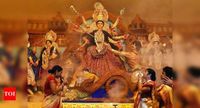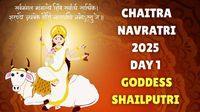Chaitra Navratri 2025, a vibrant and sacred Hindu festival, commenced on March 30 and will run until April 7. This nine-day celebration is dedicated to Goddess Durga, honoring her nine forms known as Navadurga. Each day of the festival is marked by specific rituals, colors, and the worship of a different goddess, symbolizing the triumph of good over evil.
On the first day, devotees worship Goddess Shailputri, who embodies strength, purity, and spiritual growth. This day is significant as it marks the sacred ritual of Ghatasthapana, also known as Kalash Sthapana, where a ceremonial pot is installed to invoke the divine energy of Goddess Durga. By performing this ritual, worshippers actively seek the goddess's blessings, setting a positive tone for the nine sacred days ahead.
The color orange, representing optimism and renewal, is associated with the first day of Navratri. Devotees are encouraged to wear orange attire to immerse themselves in the festive spirit. Offering sweet dishes made from milk and pure desi ghee to Mata Shailputri is a common practice, symbolizing love and devotion. The mantras recited on this day include “Om Devi Shailputreyi Namah” and “Ya Devi Sarva Bhuteshu, Shailputreyi Rupena Samsthita, Namastasyei, Namastasyei, Namastasyei Namo Namah.”
For those observing the rituals, the auspicious timings, or Shubh Muhurat, include Abhijit Muhurat from 12:01 PM to 12:50 PM, Amrit Kaal from 02:28 PM to 03:52 PM, and Sarvartha Siddhi Yog from 04:35 PM to 06:12 AM on March 31.
As the festival progresses, each day is dedicated to a different form of the goddess, with specific colors that hold spiritual significance. The second day, March 31, honors Goddess Brahmacharini, with white symbolizing peace and purity. Devotees wear white to evoke a sense of serenity and devotion. The third day, April 1, is dedicated to Goddess Chandraghanta, where the color red symbolizes strength, passion, and energy.
Goddess Kushmanda is worshipped on April 2, with royal blue representing joy and prosperity, while April 3 honors Goddess Skandamata, with yellow symbolizing happiness and optimism. On April 4, devotees celebrate Goddess Katyayani, wearing green to signify growth and renewal. The following day, April 5, is dedicated to Goddess Kalaratri, where wearing grey represents transformation and strength.
As the festival continues, April 6 is dedicated to Goddess Mahagauri, with peacock green symbolizing hope and compassion. Finally, on April 7, devotees honor Goddess Siddhidatri, wearing pink to represent love, hope, and new beginnings.
Throughout these nine days, the various colors serve to enhance the spiritual connection between devotees and the divine. Each hue is believed to attract positive energy and blessings from the respective goddess. The practice of wearing designated colors each day is not just a tradition but a means of seeking divine protection and prosperity.
Chaitra Navratri is celebrated with great enthusiasm across India, with various cultural practices and rituals. In Gujarat, for instance, Garba dances fill the nights, while in West Bengal, the festival culminates in grand Durga Puja celebrations. The diversity in celebrations reflects the rich cultural tapestry of India, where each region adds its unique flavor to the festivities.
As devotees engage in prayers, fasting, and rituals, they also partake in communal celebrations, reinforcing the spirit of unity and devotion. The festival serves as a reminder of the importance of faith, resilience, and the pursuit of spiritual growth.
In conclusion, Chaitra Navratri 2025 is not just a religious observance; it is a celebration of life, strength, and the enduring power of the divine feminine. As devotees embark on this spiritual journey, they seek blessings for a fruitful and enlightened path ahead, embodying the essence of the goddess they worship.







